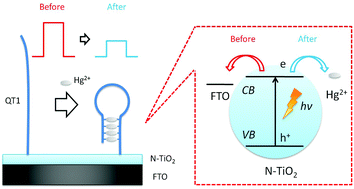N-doped TiO2 based visible light activated label-free photoelectrochemical biosensor for detection of Hg2+ through quenching of photogenerated electrons†
Abstract
A novel photoelectrochemical (PEC) biosensor was fabricated based on N-doped TiO2 for the detection of Hg2+ through the quenching of photogenerated electrons. The N-doped TiO2 was synthesized by a sol–gel method with urea and tetrabutyl titanate as the N and Ti sources. Compared with the undoped TiO2, the N-doped TiO2 showed an enhanced photocurrent response under visible light (λ > 420 nm). The sensing surface was functionalized with 5′-amino-modified T-rich oligonucleotides. The photoelectrochemical biosensor bound Hg2+ on the surface by a highly specific T–Hg2+–T recognition. Hg2+ on the surface of the N-doped TiO2 film withdrew the photogenerated electrons and decreased the recorded current signal. The dynamic linear range for Hg2+ has been determined to be as low as 2–6 μM.


 Please wait while we load your content...
Please wait while we load your content...